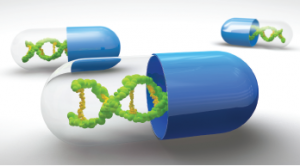
Festa / SHUTTERSTOCK.COM
SAN DIEGO—An increasing number of patients is being identified with deficiency of adenosine deaminase type 2 (DADA2); fortunately, researchers and clinicians continue to better understand the genetic disease as well, experts said in a session at the 2017 ACR/ARHP Annual Meeting Nov. 3–8.
The childhood-onset disease involves loss-of-function mutations to the CECR1 gene (i.e., cat eye syndrome critical region candidate 1), which encodes the enzyme adenosine deaminase 2 (ADA2), the growth factor-like function of which seems to play the biggest role in the disease. Symptoms include fevers, early onset of strokes, vasculitis and livedo racemosa. Cat eye syndrome is not the same as DADA2.
Paul Brogan, MBChB, PhD, professor of rheumatology at University College London (UCL) in London, England, described a disease that doesn’t fit neatly into a box. It gives rise to autoinflammatory features, autoimmune features and immunodeficiency. Autoinflammation and vasculitis arises because monocytes have impaired differentiation toward anti-inflammatory M2 macrophages and skew toward the pro-inflammatory M1 variety. And, there’s an upregulation of neutrophil-related genes. The disease also involves an immunodeficiency aspect, with reduced memory B cells and increased B cell mortality.
The differential diagnosis is wide ranging, spanning any type of sporadic vasculitis, other monogenic autoinflammatory diseases such as STING-associated vasculopathy with onset in infancy (SAVI) and chronic atypical neutrophilic dermatosis with lipodystrophy and elevated temperature (CANDLE), immunodeficiency, marrow failure and Castleman’s disease.
Clinicians should consider screening for DADA2 in cases of early-onset polyarteritis nodosa (PAN), familial PAN, PAN with cutaneous and neurological involvement or when PAN resists conventional therapy, Dr. Brogan said.
There have been no formal trials yet for DADA2 treatment, Dr. Brogan said. Doctors use corticosteroids in virtually all patients, but he says it’s not a good long-term option.
“There’s a growing consensus that anti-TNF is the preferred treatment for auto-inflammation vasculitis,” he said. “But in whom and when to start the treatment, particularly for patients who have minimal symptoms, remain controversial and a point for discussion.”
Allogeneic hematopoietic stem cell transplantation has produced encouraging results. Researchers reported results last year from 14 patients who’d had bone marrow dysfunction or immunodeficiency in the United States and five European countries. At a median of 18 months of follow-up (ranging from five months to 13 years), all of the patients remained alive and doing well, with no new vascular events, and resolution of their marrow failure and immunodeficiency.1
But Dr. Brogan pointed out the potential problems of post-transplant hematological autoimmunity, acute graft vs. host disease and other complications. And in his lab, work is afoot to develop gene therapy for the disease, he said. At least on a theoretical basis, he said, “… it should be possible. This is a recessive monogenic disease. And that correction for a single gene should restore the ADA2 enzyme activity and cure the problem.”
Researchers have been able to induce the needed cell line in experiments. The idea now is to develop a self-inactivating lentivirus that encodes CECR1. “Gene therapy might be an option for the future,” Dr. Brogan said.
Paul Brogan, MBChB, PhD, … described a disease that doesn’t fit neatly into a box.
Mechanism Studies Continue
Ivona Aksentijevich, MD, a staff scientist with the National Human Genome Research Institute in Bethesda, Md., said researchers are trying to further understand the genetic mechanisms underlying a spectrum of phenotypes associated with DADA2. She said clinical manifestations of the disease can vary greatly from patient to patient, or even among family members who carry the same pathogenic gene mutations, so the disease phenotype can’t be explained only by the mutant ADA2 genotype. This suggests a role for other genetic modifiers, epigenetic or environmental factors, she said.
She also said it’s not possible to predict based on genotype whether a patient will present with immunodeficiency, bone marrow failure, vasculopathy or recurrent strokes.
ADA2 protein is homologous to ADA1 protein that’s deficient in patients with severe combined immunodeficiency (SCID). ADA1 is highly expressed in lymphocytes, while ADA2 is expressed in activated myeloid cells. In addition, studies in model organisms showed ADA2 features properties of a growth factor and is important for development of fruit flies, frogs and mice.
Researchers also continue to investigate the role of ADA2 in angiogenesis and how the deficiency of ADA2 leads to vascular damage.
“The intriguing question is whether ADA2 regulates the differentiation of endothelial cells, or whether damage to endothelial cells is caused by activated myeloid cells,” said Dr. Aksentijevich. It’s possible, she said, that ADA2 enhances neovascularization, given that M2 macrophage differentiation is promoted by ADA2. Recent findings by another group suggest expression of ADA2 correlates with microvascular density in glioblastomas.
Researchers also wonder whether the lack of ADA2 deaminase function, similar to ADA1 deficiency in SCID, contributes to the bone marrow dysfunction seen in a subset of DADA2 patients. “The question is whether the bone marrow failure is due to an intrinsic defect in hematopoietic cells, or is the consequence of perturbations in the bone marrow environment,” she said. ADA1 and ADA2 bind to different subsets of immune cells to modulate immune responses, and blood samples from ADA2-deficient patients showed a reduction in leucocyte subsets such as B cells and neutrophils.2
“It appears,” Dr. Aksentijevich said, “that ADA2 contributes to the disease pathogenesis both through its growth factor-like function, and also possibly through the lack of its deaminase function.”
Thomas R. Collins is a freelance writer living in South Florida.
References
- Hashem H, Kumar AR, Muller I, et al. Hematopoietic stem cell transplantation rescues the hematological, immunological and vascular phenotype in DADA2. Blood. 2017 Dec 14;130(24):2682–2688.
- Zhu C, Chrifi I, Mustafa D, et al. CECR1-mediated cross talk between macrophages and vascular mural cells promotes neovascularization in malignant glioma. Oncogene. 2017 Sep 21;36(38):5356–5368.


